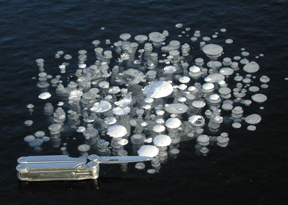|
News Notes
Climate
Methane burps below the ice
 In Siberia and other parts of the Arctic, lakes form when permafrost melts and the ground settles, creating a depression in which meltwater collects. Along the edges of these “thaw lakes,” carbon once trapped in the melting permafrost sinks to the bottom of the lake, where it decomposes and produces methane. The gas escapes to the atmosphere primarily as bubbles that rise through the lake. Scientists have now found a way to estimate this bubble flux, and have found that the flux is as much as five times higher than previously thought, which they say could significantly affect climate as the permafrost continues to melt.
In Siberia and other parts of the Arctic, lakes form when permafrost melts and the ground settles, creating a depression in which meltwater collects. Along the edges of these “thaw lakes,” carbon once trapped in the melting permafrost sinks to the bottom of the lake, where it decomposes and produces methane. The gas escapes to the atmosphere primarily as bubbles that rise through the lake. Scientists have now found a way to estimate this bubble flux, and have found that the flux is as much as five times higher than previously thought, which they say could significantly affect climate as the permafrost continues to melt.
Methane bubbles frozen in the ice of a Siberian lake offer a visible target to scientists seeking to estimate how much methane the lakes emit. Photograph is by Katey Walter.
Although scientists have good estimates of total annual global methane emissions, partitioning those total emissions among separate sources still includes large uncertainties, particularly for Arctic lakes, says Ed Dlugokencky, a chemist at the National Oceanographic and Atmospheric Admin-istration’s Earth System Research Laboratory in Boulder, Colo. In particular, the bubbles burping from these lakes change over space and time, making it difficult to measure how much total methane the lakes emit.
To better understand the contribution of methane from thaw lakes, Katey Walter, a biogeochemist at the University of Alaska at Fairbanks, and her team devised a way to estimate the bubble flux from the lakes. They observed how, each autumn, bubbles of methane gas rising from the sediments became trapped in the freezing lake, like a string of white beads descending from the surface. In some cases, the flux of bubbles was large enough to create open holes, or “hotspots,” in the lake ice. Those frozen bubbles and hotspots provided measurement targets for the researchers.
Placing umbrella-shaped bubble traps over these spots, the researchers measured bubble fluxes year-round from two lakes in North Siberia’s permafrost wetlands from April 2003 through May 2004. They then extrapolated those estimates to a regional scale, based on where hotspots appear in aerial photographs.
As reported in the Sept. 7 Nature, the researchers found that the bubbles were responsible for 95 percent of the total methane flux from the two lakes. They also found that the total methane flux from the lakes increased previous estimates of total methane emissions from northern-latitude wetlands, including the thaw lakes, by 10 to 63 percent.
Additionally, carbon isotopic values show that much of the methane dates to the Pleistocene age (35,000 to 42,000 years ago), suggesting that that carbon, buried in the permafrost since the Pleistocene era, is now thawing. As methane is a greenhouse gas, continued melting of the permafrost could result in a significant feedback to climate warming, the team reported.
Walter’s team’s study is “very good, interesting work,” Dlugokencky says. “They’ve done a thorough job of narrowing the uncertainties of methane emissions” from the lakes, he says. He notes, however, that although methane emissions from these lakes are likely to increase as the permafrost melts, they have yet to make a discernible impact on the global methane budget.
“We’re not yet seeing significant increases in emissions,” Dlugokencky says. However, “permafrost regions are very unstable, and the rate at which they melt and form lakes is unknown — making it difficult to know timescales for those increases,” he says. “It’s happening, but it’s happening very slowly so far.”
Carolyn Gramling

 Subscribe
Subscribe

